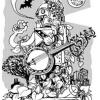The world is all wrong. I mean it. I’m not saying were all damned to Hell, but take a look around. Youll find avarice, hopelessness, human sacrifice, ecological destruction, Styrofoam food, a lobotomized pop culture, ambient noise, and a world population that keeps spreading and sprawling out across the globe like a Rorschach blot on your mee-maws Easter tablecloth. Sure, theres other stuff, too. Good stuff like generosity, courage and selflessness that could easily lead to a near-miraculous fourth-quarter recovery for our species. And who knows how its all gonna go down? Personally, I’m open to the possibility of an indestructible sanity within the heart of mankind that helps us to make a late save. But I’m also keenly aware of the obviously foul zeitgeist I got born into. Like most people from my generation (first-generation latchkey kids who grew up on movies like The Day After and War Games and who enjoyed high scores on a video game named “Rush’n Attack”), Im half-expecting the world to blow up at any minute. And, yes, okay, maybe I’ve got some unresolved psychological issues there. But seriously, when you cant carry a bottle of water onto an airplane because it might be a bomb, the End Of The World As We Know It must be nigh.
And so for the purposes of having a game plan, let’s just go ahead and mentally flash to bang time: You’re at Sanford Stadium, trashed, screaming Go Dawgs! Sic ’em! when you see the airplane. Then theres a light in the sky, some shockwaves and an atomic boom. Fade to the smell of sulfur and melting clocks, 30 years of pitch-black night, and a handful of survivors left to wander through the fallout, in search of potable water and grub. Oh yeah, and they’re also in search of safe asylum from the nuclear mutants who will most probably, in all likelihood, be cannibals as well. And how will Georgians, and in fact all of mankind, know where to regroup after the Big Bad Bang? What will bring order to the scattered remnants of humanity once it has all but obliterated
Mysterious Stranger
For those who don’t know, the Guidestones are a piece of local history along the lines of the Iron Horse, The Tree That Owns Itself, and that dense Japanese bamboo thicket on Grady Avenue: roadside oddities of peculiar origin that dont really fit with their surroundings in any conventional way. You drive by any of these places and, unless you’re running late on your way to prayer meeting or “The Simpsons,” you’ll pull over, roll down your window to marvel at the weirdness of it and cry to your sweet thing riding shotgun, Damn, baby. There has got to be a story there! And man, yeah, theres a story to the Georgia Guidestones all right. Here’s the bare bones (as told to me by my father, who heard it from his colleague, Jack Wiggins, who knows everything): One summer in the late 1970s, a mysterious, well-dressed stranger arrived in Elberton, GA, and walked through the door of Elberton Granite Finishing Company. He sat right down and said something like, You can call me R.C. Christian, though that ain’t my real name. He then proceeded to place an order massive and bizarre enough to garner the attention of the president of the company, who – according to the legend – decided to meet with the mysterious R.C. Christian for a little tête-à-tête. In private, Christian explained to the president of the granite company that he wanted to erect a number of 19-foot-tall granite slabs on some nearby land and engrave them with words for future generations to survive by. There might’ve been some talk about Thomas “Age Of Reason” Paine, who was, ostensibly, a big inspiration for the mysterious man. And there was certainly talk of funding, as in “Do you have a way to pay for this?” and “Yes, indeed, I do.”
That was the deal. The rest is Georgia history. The Georgia Guidestones, as they came to be known, were erected out in a pasture eight miles north of Elberton on Georgia Hwy. 77. They were engraved with a set of 10 admonitions about human civilization and ecological harmony, presented in eight different translations. (After all, when the End Of Time comes, the handful of survivors left wandering the Earth like Charlton Heston in Omega Man could be from just about anywhere: Egypt, Guatemala, Israel – you name it.) Also, there were holes strategically drilled in the pillars, to be used for sighting celestial events and keeping time after the nuclear holocaust.
See For Yourself
If you want to see this for yourself, just head on out there. They’ve got a nice little gravel parking lot, some rose bushes planted, and a placard with detailed specs of the Guidestones (and a mysterious reference to a time capsule planted nearby, to be dug up on a date left unspecified).

The Missus and I drove out there in our Ford Taurus a few weeks ago, for our first somber/ inspirational gander at the Guidestones. It was a sunny and clear day, so we had to squint in order to imagine a post-apocalyptic atmosphere of radiation and toxicity. Our dog, Stella, frolicked and galloped around the pillars. I threw sticks for her to retrieve and wondered, What wily animals – besides cockroaches – will survive the water bottle bomb that ends All Creation? Will any? Or will the slate be wiped totally clean and planet Earth rendered as inert and lifeless as, say, Jupiter? Well, assuming human survival, I discovered that, yea, verily, The Guidestones would probably make a pretty good meeting place – a kind of thermonuclear Honeycomb Hideout – for humanity’s scattered remnants. That granite is over 300 million years old, you know. Its made it this far, so its got a better shot at holding up under nuclear duress than, say, your local megachurch, strip mall, civic center or stadium. Its prime location, atop one of the regions many rolling hillocks, is also advantageous for spotting allies of survival, potential mates for global repopulation, and the inevitable bands of marauding, mutant punk rocker cannibals. Good stuff. Aside from all that, the whole thing functions as a pretty intense piece of art for us pre-apocalyptic folks, too. I mean, the granite slabs are meant to evoke monument as well as guidepost. And monument is just a prettier way of saying tombstone, so the Guidestones are sorta like a tombstone for the entire world population.
Heavy enough for you? (No wonder R.C. Christian got so much attention that day he placed his order at the finishing company.) Personally, the Stones reminded me of the haunting occasion when I visited my familys cemetery plot, poked around, and spied my still-alive-and-well Grandmas empty plot. She was standing right next to me. Some day, but not any time soon, I hoped. And that was that. Add this personal and global death anxiety to the controversy of the provocative words of advice scribed into the stones and youve got yourself a complex and dynamic little piece of work out north of Elberton. And its out there right now, waiting for you to come visit. Why not? Its cool. Its free. And best of all, you don’t have to take an airplane to get there. So feel free to bring along all the bottled water you want. You can even clip your toenails, peel a peach with a pocketknife, and recite the Koran aloud out there. Nobodys gonna hassle you. Not in Elbert County, the county seat of the apocalypse. As for the world being all wrong, well keep in mind that the Guidestones were built in the late 1970s and came into their own in the early ’80s, when the Cold War was ripening. Russia was in Afghanistan and the Arms Race was rocking. Every American was terrified of Russia, deep in their guts. It was a bleak time for our country and the world. Nowadays, things are either, better, worse or much worse, depending on who you talk to. And all of ’em are probably right. Me and The Missus – you might say were conflicted on the issue. Im more jaded than she is, thats for damn sure. But were both still sane enough to have hope. And we both give a hell about the world around us, however apocalypse-bound we might all be.
Jonathan Railey is a psychotherapist practicing in Athens.
Like what you just read? Support Flagpole by making a donation today. Every dollar you give helps fund our ongoing mission to provide Athens with quality, independent journalism.










